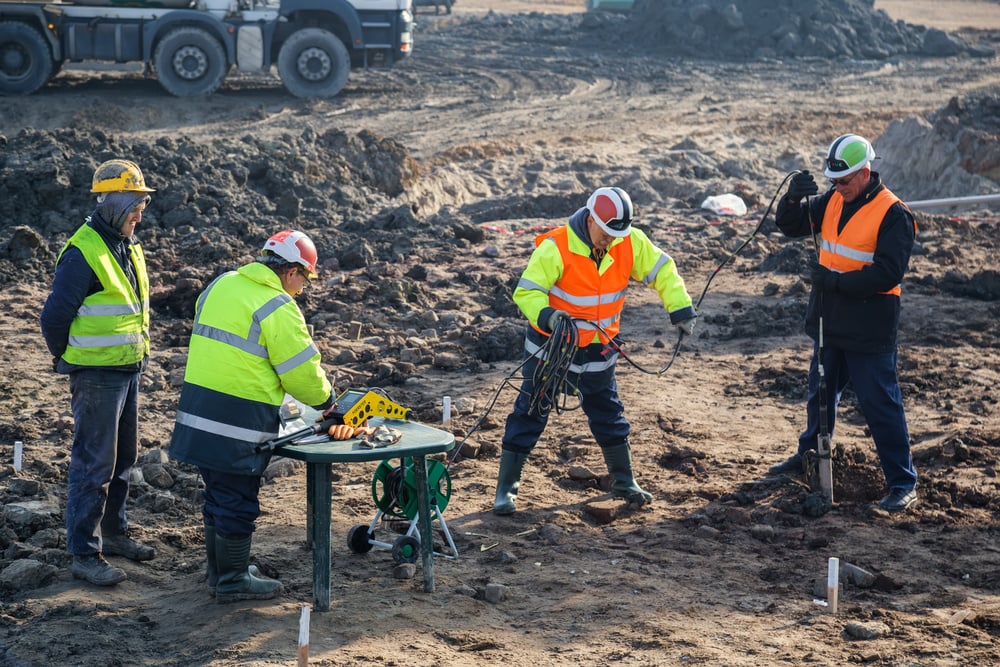6 Easy Facts About Specialized Geotechnical Engineering Solutions Explained
6 Easy Facts About Specialized Geotechnical Engineering Solutions Explained
Blog Article
The 25-Second Trick For Specialized Geotechnical Engineering Solutions
Table of ContentsAll about Specialized Geotechnical Engineering SolutionsThe Facts About Specialized Geotechnical Engineering Solutions RevealedHow Specialized Geotechnical Engineering Solutions can Save You Time, Stress, and Money.Not known Facts About Specialized Geotechnical Engineering SolutionsThe Single Strategy To Use For Specialized Geotechnical Engineering SolutionsThe 5-Minute Rule for Specialized Geotechnical Engineering Solutions
William Rankine, a designer and physicist, developed an alternative to Coulomb's earth stress concept. Albert Atterberg established the clay consistency indices that are still made use of today for dirt category. In 1885, Osborne Reynolds recognized that shearing causes volumetric extension of thick products and tightening of loose granular materials. Modern geotechnical design is claimed to have actually started in 1925 with the publication of Erdbaumechanik by Karl von Terzaghi, a mechanical designer and rock hound. Terzaghi also developed the framework for concepts of bearing capacity of structures, and the theory for prediction of the price of settlement of clay layers because of combination. After that, Maurice Biot completely established the three-dimensional soil consolidation concept, prolonging the one-dimensional design formerly developed by Terzaghi to a lot more general hypotheses and presenting the collection of basic formulas of Poroelasticity.
Geotechnical designers investigate and determine the buildings of subsurface problems and materials.
Some Known Incorrect Statements About Specialized Geotechnical Engineering Solutions
Still, they are occasionally made use of to permit a rock hound or designer to be lowered right into the borehole for straight visual and hand-operated exam of the dirt and rock stratigraphy. Different dirt samplers exist to fulfill the demands of various design jobs. The standard penetration examination, which uses a thick-walled split spoon sampler, is one of the most typical method to collect disrupted examples.

Generally, the user interface's specific geometry is unknown, and a streamlined interface geometry is presumed. Finite slopes need three-dimensional versions to be evaluated, so most inclines are evaluated thinking that they are considerably broad and can be stood for by two-dimensional models.
The Ultimate Guide To Specialized Geotechnical Engineering Solutions

Measurement of quantities and analysis of actual conditions. Design adjustment per real problems The empirical approach is ideal for building and construction that has actually currently started when an unexpected advancement occurs site link or when a failure or mishap looms or has already taken place. It disagrees for tasks whose layout this can not be changed during building.
Principles of Geotechnical Engineering. Dirt Auto Mechanics and Foundations. Interrupted soil residential properties and geotechnical design, Schofield, Andrew N., Thomas Telford, 2006.
The Greatest Guide To Specialized Geotechnical Engineering Solutions
Principles and Method of Ground Renovation. Ground Enhancement Principles And Applications In Asia. Design analysis in rock technicians.
Cengage Discovering, Stamford, 666 p. Atkinson, J., 2007. The auto mechanics of soils and foundations. Taylor & Francis, N.Y., 442 p. Floating Offshore Wind Turbines: Feedbacks in a Sea state Pareto Optimum Layouts and Financial Evaluation, P. Sclavounos et al., October 2007. Nicholson, D, Tse, C and Cent, C. (1999 ). The Observational Technique in ground engineering principles and applications.
The Main Principles Of Specialized Geotechnical Engineering Solutions
These reports are customized to meet the specific requirements of a project and include design specifications and guidance for the construction of an array of man-made structures. As well as supplying consultancy services covering areas such as incline security and load-bearing capabilities for various materials, these engineers embark on r & d tasks to improve methods, useful reference tools, materials expertise and analysis covering entire lifecycles (Specialized Geotechnical Engineering Solutions).
Design the residential properties and mechanics of rocks including the application of dynamics, liquid technicians, kinematics and product mechanics. This combines geology, soil and rock auto mechanics, and structural engineering for the style and building of structures for an array of civil design jobs. This area includes anticipating the performance of structure soil and rock to a tons enforced by a structure, while considering efficiency, economy and safety.
Prices of pay usually enhance as your knowledge and skills grow, with guidelines pointing to a graduate beginning wage of in between 18,000 and 28,000 per year in the UK. This increases to 26,000 to 36,000 with a few years of experience and after that getting to 40,000 to 60,000+ for senior, chartered or master engineers.
An Unbiased View of Specialized Geotechnical Engineering Solutions
However, with the appropriate application it is possible to understand the occupation and gain access to a difficult yet rewarding and crucial career. A geologist would certainly need to re-train to come to be a geotechnical engineer, although there is plenty of cross-over between both careers, which could make this much easier. Geologists require to have an understanding of soils, rocks and other products from a clinical perspective, while geotechnical engineers story their understanding of issues such as dirt and rock technician, geophysics and hydrology and apply them to design and ecological jobs.
When beginning out, these engineers will tend to deal with much less intricate projects, accumulating understanding and experience prepared for more difficult job later on. Geotechnical designers have a tendency to be experts in specific areas as they expand in experience, concentrating on certain facilities such as trains, roadways or water. These designers also collaborate with renewable resource, offshore and onshore oil and gas, nuclear power, and extra.
Report this page